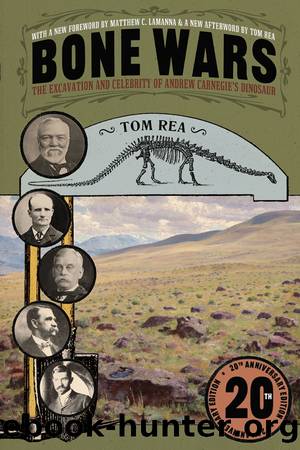Bone Wars by Unknown

Author:Unknown
Language: eng
Format: epub
ISBN: 9780822988472
Publisher: University of Pittsburgh Press
The earth sciences around 1900 were tangled in a web of conflicting explanations which it would take more than sixty years and one big theory to unravel. The problem began with a good idea that happened to be wrong. For much of the nineteenth century, scientists assumed Earth was continuing to cool from a fiery beginning. As it cooled, it shrank, and its crust bent down into ocean basins or buckled up into mountains, like the skin of a drying apple. Continents were permanently located, though the presence on dry land of marine fossils made it appear that sometimes land sank under oceans and ocean basins rose to become land. If similar extinct species were found in places far apart, even oceans apart, it must be because land bridgesâcauseways, they were sometimes calledâwere from time to time exposed by falling seas, allowing relatively temporary migrations. As for plants, well, their spores could cross oceans on the winds and their seeds on the currents.
Physicists such as Lord Kelvin and others applied thermodynamic theory to the Earth to figure out how fast an object of its size would have cooled to its present state from a temperature as hot as the sunâs. Kelvin, who had enormous prestige, first proposed that the earth was only 100 million years old, then shrank his estimate to 20 million. His ideas were widely accepted in the physical sciences, though for decades many geologists, convinced that the processes of uplift, erosion, and deposition must take much longer, were uncomfortable with Kelvinâs calculations. With or without Kelvinâs additions, the apple-skin model likewise did little to explain why mountains were distributed so unevenly around the earth.
As far back as the 1850s, British engineers in India found that the Himalayas were far less dense, as shown by gravity measurements taken with swinging plumb bobs, than anyone had expected. Gradually this perception led to the concept of isostasy, which proposes that continents, their rocks relatively light, follow Archimedesâ Principle and bob like huge rafts on a hot, dense, viscous mantle below them. Beginning in the 1890s, the Curies discovered that uranium was unstable and would break down into lead at a consistent rate. Radioactive dating of rocks became possible. The earthâs ageâgeologyâs great question of the nineteenth centuryâwas becoming measurable at last. Kelvin, it gradually became clear, was wrong, and the whole cooling-earth idea was wrong, too. But for decades, no one had a better idea.
Hatcher was by no means the only paleontologist who was scratching his head about so-called faunal homologiesâthat is, similarities between animalsâcontinents apart. As early as the 1850s, the British zoologist Philip Sclater had noticed that Madagascar contained almost none of the common African animalsâmonkeys, elephants or lions, for exampleâbut did have lots of lemurs, which are common in India, 2,500 miles away. In fact, some of the lemurs in Madagascar and India were nearly identical.
The advance of Darwinâs theory of evolution by natural selection, beginning in the 1860s, made it clear that the lemurs were too similar to have evolved independently.
Download
This site does not store any files on its server. We only index and link to content provided by other sites. Please contact the content providers to delete copyright contents if any and email us, we'll remove relevant links or contents immediately.
Sapiens: A Brief History of Humankind by Yuval Noah Harari(14323)
The Tidewater Tales by John Barth(12627)
Mastermind: How to Think Like Sherlock Holmes by Maria Konnikova(7281)
Do No Harm Stories of Life, Death and Brain Surgery by Henry Marsh(6910)
The Thirst by Nesbo Jo(6882)
Why We Sleep: Unlocking the Power of Sleep and Dreams by Matthew Walker(6659)
Life 3.0: Being Human in the Age of Artificial Intelligence by Tegmark Max(5520)
Sapiens by Yuval Noah Harari(5328)
The Longevity Diet by Valter Longo(5044)
The Body: A Guide for Occupants by Bill Bryson(5034)
The Rules Do Not Apply by Ariel Levy(4912)
The Immortal Life of Henrietta Lacks by Rebecca Skloot(4552)
Animal Frequency by Melissa Alvarez(4431)
Why We Sleep by Matthew Walker(4397)
The Hacking of the American Mind by Robert H. Lustig(4342)
Yoga Anatomy by Kaminoff Leslie(4336)
All Creatures Great and Small by James Herriot(4277)
Double Down (Diary of a Wimpy Kid Book 11) by Jeff Kinney(4245)
Embedded Programming with Modern C++ Cookbook by Igor Viarheichyk(4145)
